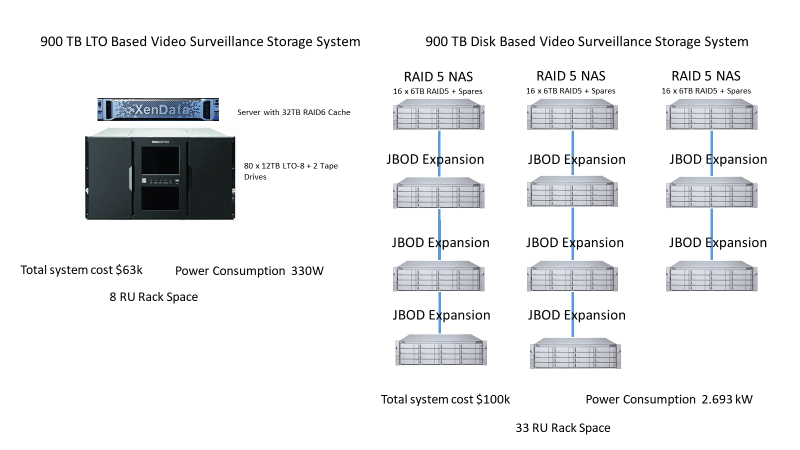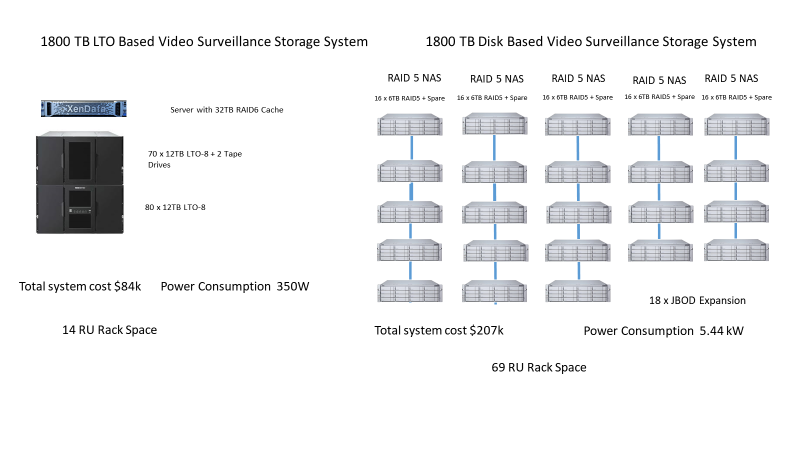Now that high capacity LTO-8 data tape systems are shipping, we have received a lot of interest in using our combined RAID-LTO systems for video surveillance storage. Retaining infrequently accessed video on low cost LTO tape combined with caching the last few days of surveillance footage on RAID saves money and makes a lot of sense.
Typical large video surveillance systems use big disk RAIDs to store the camera output for the requisite time, and the size of the storage depends on 3 factors: retention time, camera resolution and video quality (frame rate and compression). Everyone would like to have the highest resolution and best quality images they can, but typically they sacrifice quality because of the storage costs.
Here are some examples:
100 cameras 1Mpixel resolution 30 fps High Quality 30 days requires 254 TB
100 cameras 2Mpixel resolution 30 fps High Quality 30 days requires 509 TB
100 cameras 4Mpixel resolution 30 fps Med Quality 30 days requires 509TB
100 cameras 4Mpixel resolution 30 fps High Quality 30 days requires 1019 TB
XenData has LTO storage systems that have first-tier RAID and a second tier LTO tape library that offer the benefit of instant access to the most recent footage while using the lowest cost storage to retain the data for the required retention period. And because the system appears as a standard NAS device, it simply works in place of the NAS RAID storage currently used in disk based systems. The XenData systems can retain, say, the last 4-5 days of camera footage on the disk cache for instant retrieval as well as saving it, and older footage to tape. For the second-tier storage, data tape cartridges provide a very cost-effective way to keep huge volumes of video files for medium to long term retention. Restoring from LTO has longer access times – typically 2 minutes – but for most installations, this is quite acceptable.
LTO-8 cartridges are available with a native capacity of 12 TB, reducing the number of physical tapes needed significantly at a much lower cost compared to high capacity (expensive) disk drives. The LTO tapes are automatically erased and reused when the age of the video on them exceeds the specified retention time and can be used thousands of times. By combining front-end disk storage and LTO, the overall cost of a high capacity centralized video surveillance storage system is reduced dramatically.
The savings go beyond the initial purchase price because the operation costs are also much lower. Let’s compare the operating costs for our XenData LTO storage and conventional all-disk systems using two examples: a 250 camera system and a 500 camera system.
250 Camera System
The diagram shows a typical 250 camera, 2MP, 15fps video storage system needed for a retention period of 90 days. This requires approximately 900TB of storage. The LTO-8 based video storage system uses XenData software running on a Windows based server with 32TB of SAS disk drives configured as RAID6 cache (24 TB usable) and 75 LTO-8 data tapes located inside the robotics tape library, and I have compared it to a disk-only solution using low cost RAID 5 Network Attached storage units. Only brand name systems were researched for this comparison and the cost associated with the disk based systems are from currently available products. Undoubtedly lower cost white box solutions can be configured, but lack the quality, reliability, service and onsite 24 hours support necessary for a 99.9 % video storage system.
The 250 camera storage system cost is $63,000 for the XenData LTO system compared to $100,000 for the disk-only system. As you can see there is an initial cost savings when purchasing the LTO system vs disk as would be expected. But the cost savings continue to accumulate over the life of the system.
A key component of the operating costs is the electricity needed to run the system and to provide air conditioning to cool the location where the system resides. The LTO system consumes an average of 330W which is mostly for the XenData storage server. The LTO library consumption is minimal as only the tape drives in the library are powered. In contrast the disk based system requires 2.693 kW of power to operate.
What does this mean in terms of cost? Using an average 11.88 cents/kwh electricity rate for the USA, the XenData LTO system costs $343 a year to operate vs $2,803 for the equivalent disk-only system.
However, the costs do not stop there. Cooling the systems is a necessity and current methodology has a 1:1 factor for dense disk based rack systems and 0.5:1 for a low density system such as the LTO library. So our cost for cooling the LTO system is $253 per year and $2,803 for the disk-only system.
Over 5 years the electrical operating costs for the LTO system total $2,980, compared to $28,030 for the disk only system.
500 Camera System
The diagram above shows a larger 500 camera system. Here the cost savings are even more dramatic as the increase in storage for the extra video only requires additional LTO cartridges and shelf space inside the robotic library. With an initial cost of $84,000 for the LTO system vs $207,000 for a disk-only system, the initial purchase price alone would be sufficient to sway the decision on which system to buy. In addition, power consumption becomes a big factor with these larger storage systems. The LTO system only consumes 350W vs the disk based system at 5.44kW. Add in the cooling necessary and the annual cost to operate the LTO system is $628 compared to $11,333 for the disk-only system. Over 5 years this amounts to $3,144 for the LTO system and $56,665 for the disk-only system.
Post Warranty Support Costs
Now let us look at the cost of post warranty support. Our comparisons above, are for systems that have 3 years of warranty built into the initial purchase price, but what happens when we look at years 4 and 5 of our 5 year life cycle costs? The LTO storage system has a single server with a total of 8 disk drives and a tape library with 2 LTO tape drives. There are only 6 power supplies for the entire system as well as fewer cooling fans. Whereas the disk-only system has 11 chassis, 176 disk drives, 22 power supplies and many more cooling fans. Consequently, the LTO system has a lower post-warranty support cost – and for good reason.
In Conclusion
LTO systems provide substantial savings on both initial purchase costs and on-going operating costs for larger centralized video surveillance storage without sacrificing access to recent surveillance footage. For a 250 camera system with 90 days retention for a 5 year period, the LTO system are one half the cost of a disk-only equivalent system. The cost savings are even more dramatic for larger systems, the LTO system costing 1/3 the cost of the all disk system over a 5year period.


